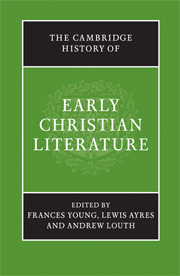Book contents
- Frontmatter
- PART ONE The Beginnings: The New Testament to Irenaeus
- PART TWO THE THIRD CENTURY
- PART THREE FOUNDATION OF A NEW CULTURE: FROM DIOCLETIAN TO CYRIL
- A LITERARY GUIDE
- 21 Classical genres in Christian guise; Christian genres in classical guise
- 22 Arnobius and Lactantius
- 23 Eusebius and the birth of church history
- 24 The fourth-century Alexandrians: Athanasius and Didymus
- 25 Palestine: Cyril of Jerusalem and Epiphanius
- 26 The Cappadocians
- 27 Fourth-century Latin writers: Hilary, Victorinus, Ambrosiaster, Ambrose
- 28 Jerome and Rufinus
- 29 Augustine
- 30 John Chrysostom and the Antiochene School to Theodoret of Cyrrhus
- 31 Cyril of Alexandria
- 32 Hagiography
- 33 Ephrem and the Syriac Tradition
- 34 The literature of the monastic movement
- 35 Women and words: texts by and about women
- 36 Conciliar records and canons
- B CONTEXT AND INTERPRETATION
- Bibliographies
- Index
- Map: The Roman Empire in the late fourth century AD"
- References
34 - The literature of the monastic movement
from A - LITERARY GUIDE
Published online by Cambridge University Press: 28 March 2008
- Frontmatter
- PART ONE The Beginnings: The New Testament to Irenaeus
- PART TWO THE THIRD CENTURY
- PART THREE FOUNDATION OF A NEW CULTURE: FROM DIOCLETIAN TO CYRIL
- A LITERARY GUIDE
- 21 Classical genres in Christian guise; Christian genres in classical guise
- 22 Arnobius and Lactantius
- 23 Eusebius and the birth of church history
- 24 The fourth-century Alexandrians: Athanasius and Didymus
- 25 Palestine: Cyril of Jerusalem and Epiphanius
- 26 The Cappadocians
- 27 Fourth-century Latin writers: Hilary, Victorinus, Ambrosiaster, Ambrose
- 28 Jerome and Rufinus
- 29 Augustine
- 30 John Chrysostom and the Antiochene School to Theodoret of Cyrrhus
- 31 Cyril of Alexandria
- 32 Hagiography
- 33 Ephrem and the Syriac Tradition
- 34 The literature of the monastic movement
- 35 Women and words: texts by and about women
- 36 Conciliar records and canons
- B CONTEXT AND INTERPRETATION
- Bibliographies
- Index
- Map: The Roman Empire in the late fourth century AD"
- References
Summary
The very notion of the ‘literature of the monastic movement’ runs the risk of accepting uncritically the propaganda that this literature constituted. The traditional story of the rise of monasticism as a fourth-century phenomenon, associated par excellence with the Egyptian desert, is a Catholic legend, which, unlike many others, was reinforced, rather than questioned, by Protestant scholarship, happy to regard monasticism as a late, and therefore spurious, development. The ‘monastic movement’ should perhaps be seen rather as a reform movement of an already existing, and flourishing, ascetic tradition: a reform inspired by changes, both within the Church itself, and in the Church’s relation to society, brought about by the gradual Christianization of the Roman Empire that began in the fourth century with the conversion of Constantine. The results of this reform movement led to the outlawing (by bishops in councils) of various hitherto acceptable forms of the ascetic life – notably those that involved ascetics of both sexes living together – and the promotion of the ideal of desert or rural monasticism (though urban monasticism continued), as depicted in the ‘monastic literature’: the net effect was to subordinate ascetic claims to authority to that of the bishop (with only limited success, especially in the East). Although all the forms of reformed monasticism – the eremitical life of solitude, life in community (‘coenobitic’) and the modified eremitical life of the laura or the ‘skete’ – can be found in Egypt, the reform of monasticism in other parts of the Empire (Syria, for instance, or Asia Minor) is probably an independent response to the changes of the fourth century, rather than evidence of Egyptian influence.
- Type
- Chapter
- Information
- The Cambridge History of Early Christian Literature , pp. 373 - 381Publisher: Cambridge University PressPrint publication year: 2004
References
- 36
- Cited by

